Gregory Dudek
Swarm Oracle: Trustless Blockchain Agreements through Robot Swarms
Sep 19, 2025Abstract:Blockchain consensus, rooted in the principle ``don't trust, verify'', limits access to real-world data, which may be ambiguous or inaccessible to some participants. Oracles address this limitation by supplying data to blockchains, but existing solutions may reduce autonomy, transparency, or reintroduce the need for trust. We propose Swarm Oracle: a decentralized network of autonomous robots -- that is, a robot swarm -- that use onboard sensors and peer-to-peer communication to collectively verify real-world data and provide it to smart contracts on public blockchains. Swarm Oracle leverages the built-in decentralization, fault tolerance and mobility of robot swarms, which can flexibly adapt to meet information requests on-demand, even in remote locations. Unlike typical cooperative robot swarms, Swarm Oracle integrates robots from multiple stakeholders, protecting the system from single-party biases but also introducing potential adversarial behavior. To ensure the secure, trustless and global consensus required by blockchains, we employ a Byzantine fault-tolerant protocol that enables robots from different stakeholders to operate together, reaching social agreements of higher quality than the estimates of individual robots. Through extensive experiments using both real and simulated robots, we showcase how consensus on uncertain environmental information can be achieved, despite several types of attacks orchestrated by large proportions of the robots, and how a reputation system based on blockchain tokens lets Swarm Oracle autonomously recover from faults and attacks, a requirement for long-term operation.
Scalable Aerial GNSS Localization for Marine Robots
May 07, 2025Abstract:Accurate localization is crucial for water robotics, yet traditional onboard Global Navigation Satellite System (GNSS) approaches are difficult or ineffective due to signal reflection on the water's surface and its high cost of aquatic GNSS receivers. Existing approaches, such as inertial navigation, Doppler Velocity Loggers (DVL), SLAM, and acoustic-based methods, face challenges like error accumulation and high computational complexity. Therefore, a more efficient and scalable solution remains necessary. This paper proposes an alternative approach that leverages an aerial drone equipped with GNSS localization to track and localize a marine robot once it is near the surface of the water. Our results show that this novel adaptation enables accurate single and multi-robot marine robot localization.
Learning Heuristics for Transit Network Design and Improvement with Deep Reinforcement Learning
Apr 15, 2024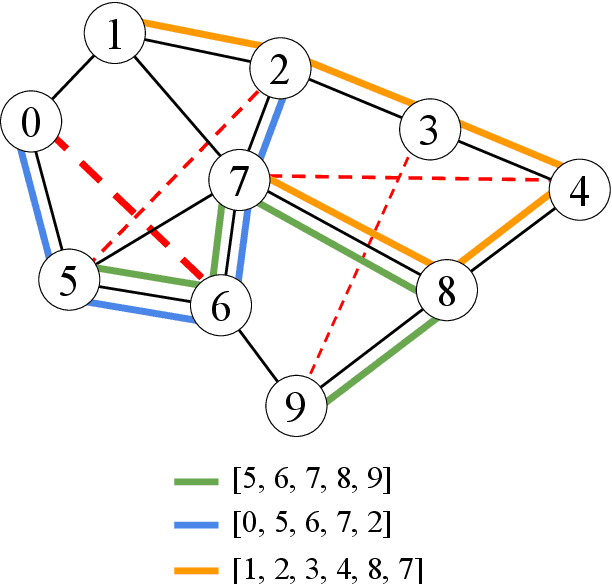

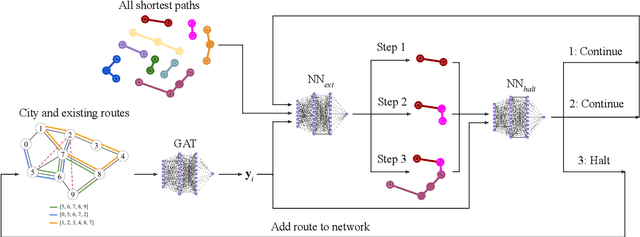

Abstract:Transit agencies world-wide face tightening budgets. To maintain quality of service while cutting costs, efficient transit network design is essential. But planning a network of public transit routes is a challenging optimization problem. The most successful approaches to date use metaheuristic algorithms to search through the space of possible transit networks by applying low-level heuristics that randomly alter routes in a network. The design of these low-level heuristics has a major impact on the quality of the result. In this paper we use deep reinforcement learning with graph neural nets to learn low-level heuristics for an evolutionary algorithm, instead of designing them manually. These learned heuristics improve the algorithm's results on benchmark synthetic cities with 70 nodes or more, and obtain state-of-the-art results when optimizing operating costs. They also improve upon a simulation of the real transit network in the city of Laval, Canada, by as much as 54% and 18% on two key metrics, and offer cost savings of up to 12% over the city's existing transit network.
Constrained Robotic Navigation on Preferred Terrains Using LLMs and Speech Instruction: Exploiting the Power of Adverbs
Apr 02, 2024Abstract:This paper explores leveraging large language models for map-free off-road navigation using generative AI, reducing the need for traditional data collection and annotation. We propose a method where a robot receives verbal instructions, converted to text through Whisper, and a large language model (LLM) model extracts landmarks, preferred terrains, and crucial adverbs translated into speed settings for constrained navigation. A language-driven semantic segmentation model generates text-based masks for identifying landmarks and terrain types in images. By translating 2D image points to the vehicle's motion plane using camera parameters, an MPC controller can guides the vehicle towards the desired terrain. This approach enhances adaptation to diverse environments and facilitates the use of high-level instructions for navigating complex and challenging terrains.
A Neural-Evolutionary Algorithm for Autonomous Transit Network Design
Mar 14, 2024Abstract:Planning a public transit network is a challenging optimization problem, but essential in order to realize the benefits of autonomous buses. We propose a novel algorithm for planning networks of routes for autonomous buses. We first train a graph neural net model as a policy for constructing route networks, and then use the policy as one of several mutation operators in a evolutionary algorithm. We evaluate this algorithm on a standard set of benchmarks for transit network design, and find that it outperforms the learned policy alone by up to 20% and a plain evolutionary algorithm approach by up to 53% on realistic benchmark instances.
A comparison of RL-based and PID controllers for 6-DOF swimming robots: hybrid underwater object tracking
Jan 29, 2024Abstract:In this paper, we present an exploration and assessment of employing a centralized deep Q-network (DQN) controller as a substitute for the prevalent use of PID controllers in the context of 6DOF swimming robots. Our primary focus centers on illustrating this transition with the specific case of underwater object tracking. DQN offers advantages such as data efficiency and off-policy learning, while remaining simpler to implement than other reinforcement learning methods. Given the absence of a dynamic model for our robot, we propose an RL agent to control this multi-input-multi-output (MIMO) system, where a centralized controller may offer more robust control than distinct PIDs. Our approach involves initially using classical controllers for safe exploration, then gradually shifting to DQN to take full control of the robot. We divide the underwater tracking task into vision and control modules. We use established methods for vision-based tracking and introduce a centralized DQN controller. By transmitting bounding box data from the vision module to the control module, we enable adaptation to various objects and effortless vision system replacement. Furthermore, dealing with low-dimensional data facilitates cost-effective online learning for the controller. Our experiments, conducted within a Unity-based simulator, validate the effectiveness of a centralized RL agent over separated PID controllers, showcasing the applicability of our framework for training the underwater RL agent and improved performance compared to traditional control methods. The code for both real and simulation implementations is at https://github.com/FARAZLOTFI/underwater-object-tracking.
PhotoBot: Reference-Guided Interactive Photography via Natural Language
Jan 19, 2024



Abstract:We introduce PhotoBot, a framework for automated photo acquisition based on an interplay between high-level human language guidance and a robot photographer. We propose to communicate photography suggestions to the user via a reference picture that is retrieved from a curated gallery. We exploit a visual language model (VLM) and an object detector to characterize reference pictures via textual descriptions and use a large language model (LLM) to retrieve relevant reference pictures based on a user's language query through text-based reasoning. To correspond the reference picture and the observed scene, we exploit pre-trained features from a vision transformer capable of capturing semantic similarity across significantly varying images. Using these features, we compute pose adjustments for an RGB-D camera by solving a Perspective-n-Point (PnP) problem. We demonstrate our approach on a real-world manipulator equipped with a wrist camera. Our user studies show that photos taken by PhotoBot are often more aesthetically pleasing than those taken by users themselves, as measured by human feedback.
Hallucination Detection and Hallucination Mitigation: An Investigation
Jan 16, 2024Abstract:Large language models (LLMs), including ChatGPT, Bard, and Llama, have achieved remarkable successes over the last two years in a range of different applications. In spite of these successes, there exist concerns that limit the wide application of LLMs. A key problem is the problem of hallucination. Hallucination refers to the fact that in addition to correct responses, LLMs can also generate seemingly correct but factually incorrect responses. This report aims to present a comprehensive review of the current literature on both hallucination detection and hallucination mitigation. We hope that this report can serve as a good reference for both engineers and researchers who are interested in LLMs and applying them to real world tasks.
Device-Free Human State Estimation using UWB Multi-Static Radios
Dec 26, 2023

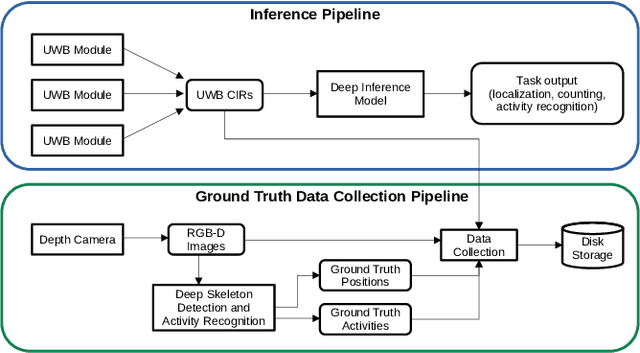
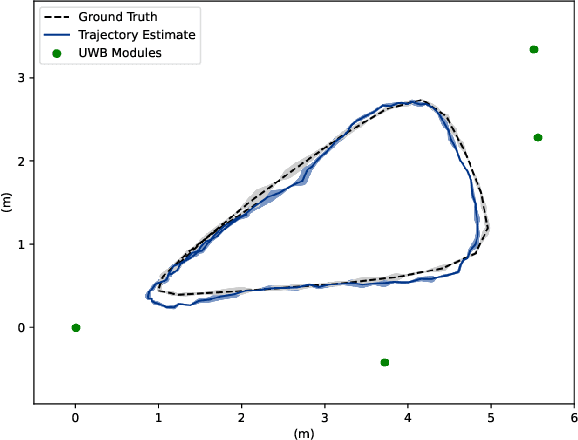
Abstract:We present a human state estimation framework that allows us to estimate the location, and even the activities, of people in an indoor environment without the requirement that they carry a specific devices with them. To achieve this "device free" localization we use a small number of low-cost Ultra-Wide Band (UWB) sensors distributed across the environment of interest. To achieve high quality estimation from the UWB signals merely reflected of people in the environment, we exploit a deep network that can learn to make inferences. The hardware setup consists of commercial off-the-shelf (COTS) single antenna UWB modules for sensing, paired with Raspberry PI units for computational processing and data transfer. We make use of the channel impulse response (CIR) measurements from the UWB sensors to estimate the human state - comprised of location and activity - in a given area. Additionally, we can also estimate the number of humans that occupy this region of interest. In our approach, first, we pre-process the CIR data which involves meticulous aggregation of measurements and extraction of key statistics. Afterwards, we leverage a convolutional deep neural network to map the CIRs into precise location estimates with sub-30 cm accuracy. Similarly, we achieve accurate human activity recognition and occupancy counting results. We show that we can quickly fine-tune our model for new out-of-distribution users, a process that requires only a few minutes of data and a few epochs of training. Our results show that UWB is a promising solution for adaptable smart-home localization and activity recognition problems.
Anomaly Detection for Scalable Task Grouping in Reinforcement Learning-based RAN Optimization
Dec 06, 2023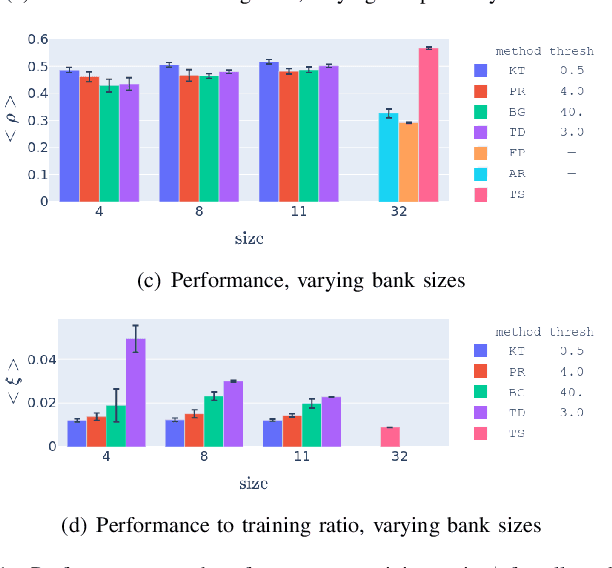
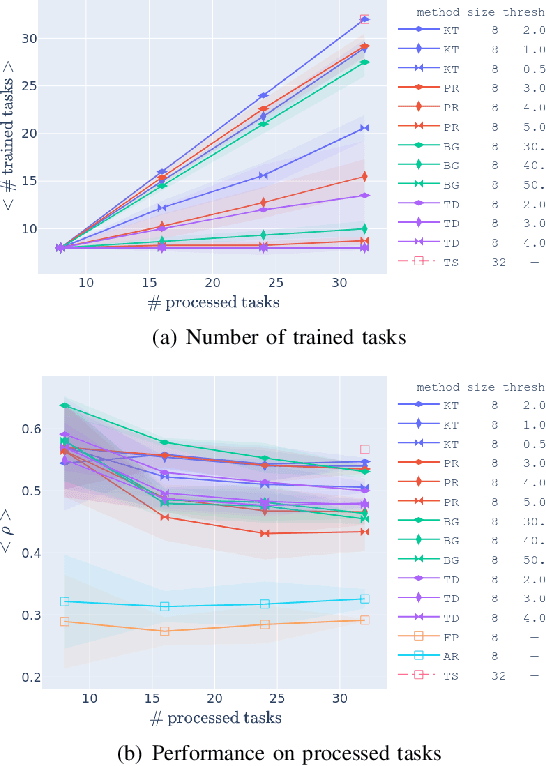
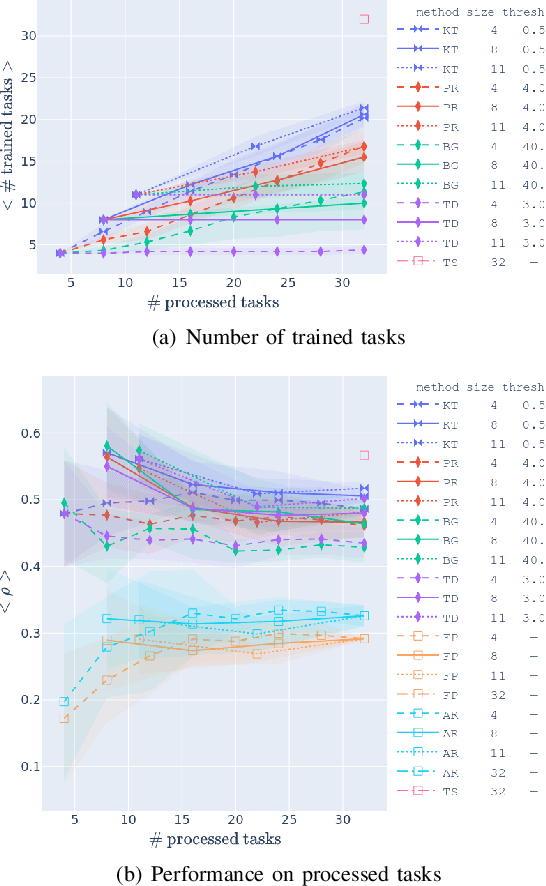
Abstract:The use of learning-based methods for optimizing cellular radio access networks (RAN) has received increasing attention in recent years. This coincides with a rapid increase in the number of cell sites worldwide, driven largely by dramatic growth in cellular network traffic. Training and maintaining learned models that work well across a large number of cell sites has thus become a pertinent problem. This paper proposes a scalable framework for constructing a reinforcement learning policy bank that can perform RAN optimization across a large number of cell sites with varying traffic patterns. Central to our framework is a novel application of anomaly detection techniques to assess the compatibility between sites (tasks) and the policy bank. This allows our framework to intelligently identify when a policy can be reused for a task, and when a new policy needs to be trained and added to the policy bank. Our results show that our approach to compatibility assessment leads to an efficient use of computational resources, by allowing us to construct a performant policy bank without exhaustively training on all tasks, which makes it applicable under real-world constraints.
 Add to Chrome
Add to Chrome Add to Firefox
Add to Firefox Add to Edge
Add to Edge